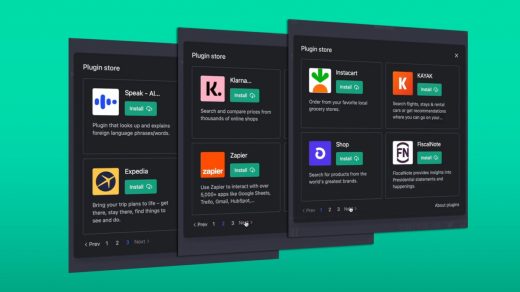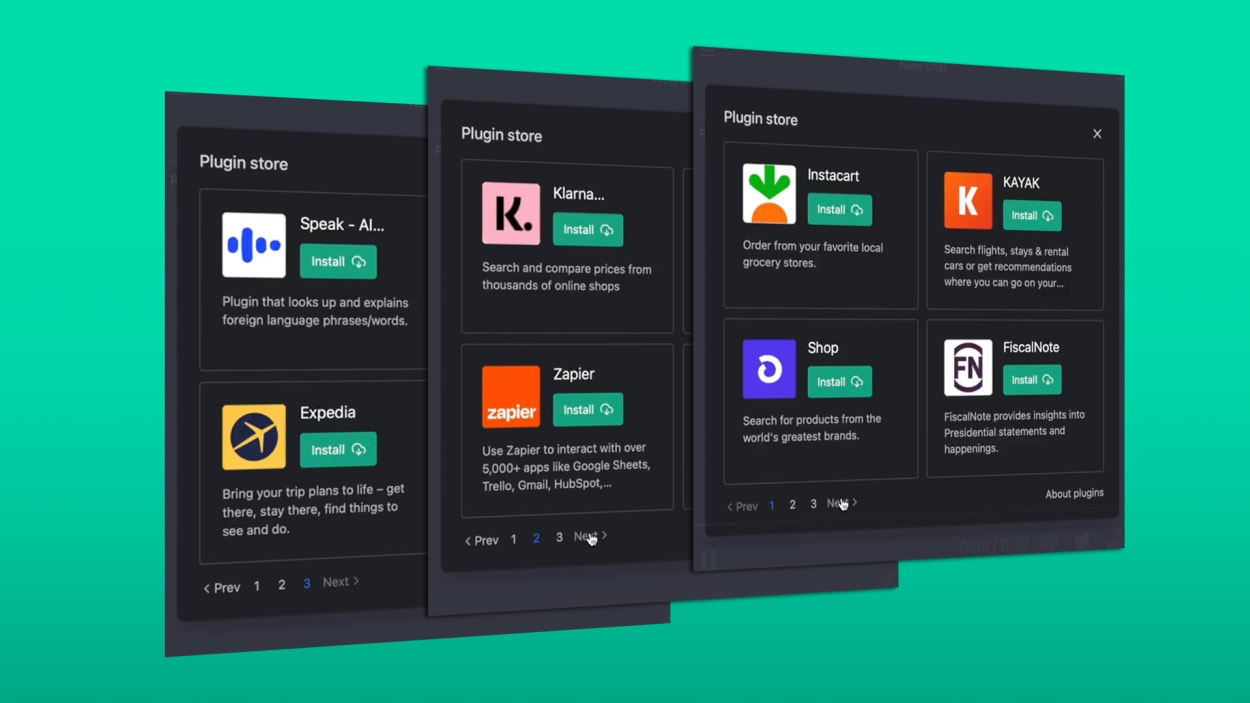Did OpenAI just have its ‘App Store’ moment?
We may have just witnessed the birth of OpenAI‘s version of an app store.
There were no splashy press events or full-page ads announcing the launch—just a few tweets and a blog post—but the modest debut of ChatGPT’s new plugin system could end up being a pivotal moment in the evolution of personal computing.
“Assume we are on the cusp of a new computing platform shift, with generative AI being the new computing platform,” says Ben Bajarin, principal analyst at market research firm Creative Strategies. “It will spread very quickly to billions of users.”
OpenAI said in the blog post that it’s rolling out its plug-in program “so we can study their real-world use, impact, and safety and alignment challenges.” Rest assured the program will rapidly advance beyond this phase.
Making chatbots useful
OpenAI’s AI chatbot, ChatGPT, has seen a meteoric rise in popularity. It climbed to over 100 million users within two months of its November 2022 launch, and has more than 13 million daily active users. Anytime a tech product creates that much energy and attracts that many eyeballs, it becomes a platform. Brands and app developers want to be there. A limited set of developers, including Instacart, Expedia, Shopify, Slack, OpenTable, and Wolfram Alfa, got the opportunity to make their plug-in available at Open AI’s ($20 per month) ChatGPT Plus service.
But OpenAI could become something far more than just a hot platform. And the plug-ins could play an important role in ChatGPT’s growth by connecting it with actionable third-party knowledge.
“It is interesting how these plug-ins, and eventually other implementations, allow for brands, companies, and services to integrate some of their own proprietary foundational models, or smaller language models, to be used in conjunction with ChatGPTs large models,” Bajarin says. “This could be an important trend to come.”
OpenAI’s plugins could represent the second major phase in the rise of AI chatbots. With ChatGPT, Google’s Bard, and Microsoft’s Bing Chat we saw “pure” chatbots trained on petabytes of text scraped from the open web. While the current chatbots can generate text that sounds trustworthy, they can also generate completely fabricated information. In chatbots’ second phase, they begin to gain access to actionable, sometimes proprietary, data and functionality, and could even begin to take action on a user’s behalf. So when ChatGPT gets a user prompt to help plan a trip, for example, it might connect with the AI model or database at Expedia to deliver real flight times and prices. It might even book the tickets on the user’s behalf.
The Wolfram Alpha plugin provides something more functional––math and science computations–which will fill a gaping hole in ChatGPT’s abilities. “ChatGPT—for all its remarkable prowess in textually generating material ‘like’ what it’s read from the web, etc.—can’t itself be expected to do actual nontrivial computations, or to systematically produce correct (rather than just “looks roughly right”) data, etc.,” writes Stephen Wolfram in a Thursday blog post. “But when it’s connected to the Wolfram plugin it can do these things.”
As OpenAI explains it its own thought-provoking blog post: “Though not a perfect analogy, plugins can be ‘eyes and ears’ for language models, giving them access to information that is too recent, too personal, or too specific to be included in the training data.”
A new kind of platform
A number of people on Twitter have commented that the launch of the ChatGPT plug-ins looked something like the launch of the iPhone App Store back in 2008.
“OpenAI is creating this intelligent OS like Apple did when it made its platform a mobile OS that allowed third party developers to build mobile apps on the platform,” says cofounder and CEO of Perplexity AI Aravind Srinivas. Srinivas worked at OpenAI as a research scientist before launching Perplexity—a conversational search engine powered in part by OpenAI’s ChatGPT—in January.
And while there are definite similarities to Apple’s store, it’s important to note the differences as well.
“This is not a dynamic we have seen before,” Creative Strategies’ Bajarin says. “New platforms which require new hardware. PCs, smartphones, VR, AR, etcetera. This new shift is accessible to everyone with a computer and that is a massive immediate opportunity.”
OpenAI is beginning its rollout of the plug-ins program just four months after the launch of ChatGPT. “It’s really amazing that they moved so fast,” Srinivas says. “It’s also amazing to see them move so fast on creating a language model that can take actions.” For example, in the future, you might be able to take a photograph of a bowl of food in front of you and consult a diet app to ask whether the ingredients are suitable.
He explains that developers might also be attracted to the opportunity to “chain” their own plug-ins with others at ChatGPT. For example, he says, a ChatGPT user could chain the diet app plug-in (for a healthy recipe idea) to Wolfram Alfa’s mathematical plug-in (to calculate how much of each ingredient to buy) to Instacart‘s plug-in (to order the ingredients).
Looking forward
Right now users will have to access the plug-in functionality from the ChatGPT Plus user interface. “But in the future OpenAI may let brands and third-party developers host the plugins at their own sites or apps,” OpenAI Engineering Lead Andrey Mishchenko writes in an email to Fast Company.
“We would like to eventually roll out plugin support for developers on our API, incorporating the lessons we learn from deployment in ChatGPT,” he adds, but his team’s priority right now is evolving the plug-ins system to suit the needs of users and developers, and to address safety issues.
But the implications of OpenAI’s plug-ins could go way beyond that.
If today’s plug-ins give OpenAI’s ChatGPT “eyes and ears,” it’s not hard to imagine another type of program giving the model “hands.” A smart home company might decide to develop a plug-in that allows a user to talk to their house (perhaps via voice interactions with ChatGPT) and control lights and window coverings and garage doors. This is a natural language model, empowered with knowledge of home devices and the user’s habits and preferences, controlling real world hardware. Consider where that could lead. We’d not be that far from Hal 9000 territory.
If we had something on our phones and computers that knows all about us, all about our belongings and property, all about our friends and family, our entertainment habits, and that could talk to us in a natural way about interacting with all of it, would we need our apps anymore?
It seems very likely that users will eventually be able to choose from hundreds of plug-ins of all kinds while using ChatGPT. Perplexity’s Srinivas says his own company, Perplexity AI, will hold conversations about the possibility of having a plug-in at ChatGPT.
“The impact on the developer community could be game-changing,” Srinivas says. “It’s probably the hottest thing right now, and if the usage really picks up, developers will want to have their plug-ins there so that they don’t miss out.”
(21)



